What's Causing the Rain Damage?
/DRONE APPLICATION: Our pilots can quickly capture details and document current conditions in hard-to-reach places.
A strong rain storm can leave a path of destruction in its wake with many business and commercial buildings suffering damage from high winds, heavy rain, fallen trees, or flying debris. Assessing the structural and environmental integrity of your facility is crucial in the aftermath of a significant storm.
What are common causes?
- Poor Drainage - If you have a flat roof and it’s not draining properly, you run the risk of ponding water. And the weight of this accumulated water can cause structural issues for the building.
- Aging System - Over the years, wear and tear on your roof may result in damage to the flashing or roof membrane cover. Wind, debris, or extreme temperatures may cause the flashing to become loose or the membrane to puncture or tear. This damage provides the water and moisture a place to go – resulting in leaks and mold in the building.
- Poor Seals - There are intentional holes in the roof membrane cover for such necessities as HVAC units, drains, or vents. If the wraps, rain collars, or pitch pans at these areas are not water-tight rain water and moisture enter the building.
Although the damage may appear to be minimal, water intrusion caused by the storm or structural damage to the building may not be readily visible; but if it’s not addressed promptly, could result in further property damage, mold growth, or other biological issues.
Did you know that mold can grow in as little as 12 hours?
Mold is one of the leading Indoor Air Quality problems, often causing significant allergies and health problems for occupants. Mold can grow almost anywhere there is water damage, high humidity, or dampness. If such conditions exist in your building, you most likely have a mold problem.
SSM’s structural engineers and Indoor Environmental Quality Specialists can evaluate the existing conditions, determine the extent of the damage or water intrusion and recommend corrective actions before conditions effect occupant health.


